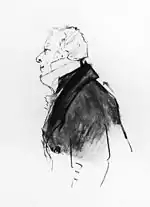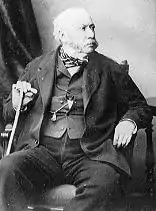Lord Privy Seal
The lord privy seal (or, more formally, the lord keeper of the privy seal) is the fifth of the Great Officers of State in the United Kingdom, ranking beneath the lord president of the Council and above the lord great chamberlain. Originally, its holder was responsible for the monarch's personal (privy) seal (as opposed to the Great Seal of the Realm, which is in the care of the lord chancellor) until the use of such a seal became obsolete. Though one of the oldest offices in European governments, it has no particular function today because the use of a privy seal has been obsolete for centuries; it may be regarded as a traditional sinecure, but today, the holder of the office is invariably given a seat in the Cabinet of the United Kingdom, and is sometimes referred to as a minister without portfolio.
| Lord Keeper of the Privy Seal | |
|---|---|
_(2022).svg.png.webp) | |
| Style | The Right Honourable |
| Type | Great Officer of State |
| Appointer | The King (on the advice of the Prime Minister) |
| Term length | At His Majesty's pleasure |
| Formation | 1307 |
| First holder | William Melton |
| This article is part of a series on |
| Politics of the United Kingdom |
|---|
_(2022).svg.png.webp) |
|
Since the premiership of Clement Attlee, the position of lord privy seal has frequently been combined with that of leader of the House of Lords or leader of the House of Commons. The office of lord privy seal, unlike those of leader of the Lords or Commons, is eligible for a ministerial salary under the Ministerial and other Salaries Act 1975.[1] The office does not confer membership of the House of Lords, leading to Ernest Bevin's remark on holding this office that he was "neither a Lord, nor a Privy, nor a Seal".[2][3]
During the reign of Edward I, prior to 1307, the privy seal was kept by the controller of the wardrobe.[4] The lord privy seal was the president of the Court of Requests during its existence.
List of lord keepers of the privy seal
Lord Keepers of the Privy Seal (c. 1307–1714)
Lord Keepers of the Privy Seal (1714–present)
- Notes
- Archdeacon of Sarum until 1426; Bishop of Norwich from 1426
- Archdeacon of Oxford 1434–1442; Bishop of St David's from 1442
- Dean of Salisbury until 1446; Bishop of Chichester from 1446
- Dean of St Paul's until 1457
- Archdeacon of Taunton until 1465; Bishop of Bath and Wells from 1466
- Bishop of Rochester from 1468
- Bishop of Rochester until 1472; Bishop of Lincoln from 1472
- Bishop of Rochester 1476–1480; Bishop of Lincoln from 1480
- Bishop of Exeter until 1492; Bishop of Bath and Wells 1492–1494; Bishop of Durham 1494–1501; Bishop of Winchester from 1501
- Concurrently held the offices of Chancellor of the Exchequer from 1533, Secretary of State from 1534, and Lord Great Chamberlain in 1540
- Baron Russell from 1539, created Earl of Bedford in 1551
- Concurrently held the office of Secretary of State
- Appointed in the controversial Oxford Parliament, Bourchier is sometimes regarded as holding the office for life. However, during the Interregnum Bourchier was identified as a Delinquent by Parliamentarians and use of the Privy Seal ended. Until the Restoration of Charles II the Great Seal was the primary seal of government, for which the custody held in commission.
- Marquess of Normanby from 1694; created Duke of Buckingham and Normanby in 1703
- Earl of Wharton from 1706; created Marquess of Wharton in 1715
- Baron Gower from 1709; created Earl Gower in 1746
- The Prince of Wales served as prince regent from 5 February 1811.
- Earl Gower from 1754; created Marquess of Stafford in 1786
- Served as President of the Board of Control from September 1828
- Served as Chancellor of the Duchy of Lancaster October 1840 – June 1841
- Served as Chancellor of the Duchy of Lancaster from May 1894
- Served as President of the Board of Trade from March 1905
- Served as Leader of the House of Lords from April 1908
- Earl of Crewe from 1895; created Marquess of Crewe July 1911
- Served as Secretary of State for the Colonies until November 1910
- Served as Secretary of State for India November 1910 – March 1911; and from May 1911
- Served as President of the Air Board from May 1916
- MP for Hitchin until 1923; created Viscount Cecil of Chelwood December 1923
- Served as Leader of the House of Lords from April 1925
- Served as Paymaster General July 1946 – March 1947
- Served as Paymaster General July 1948 – April 1949
- Served as Minister of Materials from July 1951
- Served as Secretary of State for Commonwealth Relations from March 1952
- Served as Secretary of State for the Home Department from January 1957
Other countries
- Keeper of the seals of France
- Lord Keeper of the Privy Seal of Japan
- Keeper of the Rulers' Seal of Malaysia
See also
- Chancellor of the Duchy of Lancaster
- Keeper of the Privy Seal of Scotland
- Lord Keeper of the Great Seal
- Lord Privy Seal (term), as used in the television news business
Citations
- "Ministerial and other Salaries Act 1975". www.legislation.gov.uk. Retrieved 19 March 2018.
- Beckett, Francis (1997). Clem Attlee: A Biography. London: Richard Cohen. p. 285. ISBN 9781860661013.
- Beckett, Francis (2000). Clem Attlee: A Biography. London: Politico's Publishing. p. 285 at archive.org. ISBN 9781902301709.
- Sayers, Jane. "The English Royal Chancery" (PDF). Retrieved 3 January 2012.

.svg.png.webp)
_(Attributed).svg.png.webp)
.svg.png.webp)
.svg.png.webp)
.svg.png.webp)
.svg.png.webp)
.svg.png.webp)
.svg.png.webp)
.svg.png.webp)
.svg.png.webp)
_-_Dragon_with_pizzle.png.webp)
.svg.png.webp)
.svg.png.webp)
.svg.png.webp)
.svg.png.webp)
.svg.png.webp)
.svg.png.webp)
.svg.png.webp)

.svg.png.webp)


























_after_George_Romney_of_John_Fane%252C_10th_Earl_of_Westmorland%252C_1796.jpg.webp)

.jpg.webp)
.svg.png.webp)








.svg.png.webp)
















.jpg.webp)





.jpg.webp)







.jpg.webp)


.jpg.webp)





.jpg.webp)
.jpg.webp)
_Vane-Tempest-Stewart%252C_7th_Marquess_of_Londonderry.jpg.webp)













.svg.png.webp)



















.svg.png.webp)